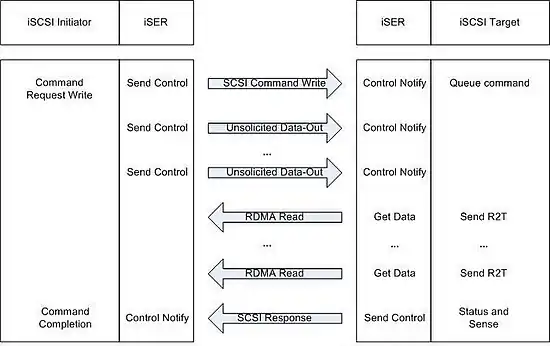iSCSI Extensions for RDMA
The iSCSI Extensions for RDMA (iSER) is a computer network protocol that extends the Internet Small Computer System Interface (iSCSI) protocol to use Remote Direct Memory Access (RDMA). RDMA is provided by either the Transmission Control Protocol (TCP) with RDMA services (iWARP) that uses existing Ethernet setup and therefore no need of huge hardware investment, RoCE (RDMA over Converged Ethernet) that does not need the TCP layer and therefore provides lower latency, or InfiniBand. It permits data to be transferred directly into and out of SCSI computer memory buffers (which connects computers to storage devices) without intermediate data copies and without much CPU intervention.
History
An RDMA consortium was announced on May 31, 2002, with a goal of product implementations by 2003.[1] The consortium released their proposal in July, 2003.[2] The protocol specifications were published as drafts in September 2004 in the Internet Engineering Task Force and issued as RFCs in October 2007.[3][4] The OpenIB Alliance was renamed in 2007 to be the OpenFabrics Alliance, and then released an open source software package.[5]
Description
The motivation for iSER is to use RDMA to avoid unnecessary data copying on the target and initiator. The Datamover Architecture (DA) defines an abstract model in which the movement of data between iSCSI end nodes is logically separated from the rest of the iSCSI protocol; iSER is one Datamover protocol. The interface between the iSCSI and a Datamover protocol, iSER in this case, is called Datamover Interface (DI).
The main difference between the standard iSCSI and iSCSI over iSER is the execution of SCSI read/write commands. With iSER the target drives all data transfer (with the exception of iSCSI unsolicited data) by issuing RDMA write/read operations, respectively. When the iSCSI layer issues an iSCSI command PDU, it calls the Send_Control primitive, which is part of the DI. The Send_Control primitive sends the STag with the PDU. The iSER layer in the target side notifies the target that the PDU was received with the Control_Notify primitive (which is part of the DI). The target calls the Put_Data or Get_Data primitives (which are part of the DI) to perform an RDMA write/read operation respectively. Then, the target calls the Send_Control primitive to send a response to the initiator. An example is shown in the figures (time progresses from top to bottom).


All iSCSI control-type PDUs contain an iSER header, which allows the initiator to advertise the STags that were generated during buffer registration. The target will use the STags later for RDMA read/write operations.
See also
- LIO Linux SCSI Target
- The SCST Linux SCSI target software stack
- SCSI RDMA Protocol
References
- "Open Consortium Developing Specifications for Remote Direct Memory Access Over TCP/IP Networks" (PDF). press release. May 31, 2002. Retrieved May 5, 2011.
- Mike Ko; et al. (July 2003). "iSCSI Extensions for RDMA Specification (Version 1.0)" (PDF). Retrieved May 5, 2011.
- M. Ko; et al. (October 2007). "Internet Small Computer System Interface (iSCSI) Extensions for Remote Direct Memory Access (RDMA)". RFC 5046.
- M. Chadalapaka; et al. (October 2007). "DA: Datamover Architecture for the Internet Small Computer System Interface (iSCSI)". RFC 5047.
- "OpenFabrics Alliance". official web site. Retrieved May 4, 2011.
Further reading
- Mallikarjun Chadalapaka; Hemal Shah; Uri Elzur; Patricia Thaler; Michael Ko (2003). "A study of iSCSI extensions for RDMA (ISER)". Proceedings of the ACM SIGCOMM workshop on Network-I/O convergence: Experience, lessons, implications. Association for Computing Machinery. pp. 209–219. CiteSeerX 10.1.1.581.8693. doi:10.1145/944747.944754. ISBN 978-0123456786. S2CID 15065381.
- Ethan Burns (May 2008). Implementation and Comparison of iSCSI over RDMA (PDF). University of New Hampshire. Retrieved November 11, 2019. Thesis for Master of Science in Computer Science
External links
- "RDMA model". IBM Research - Zurich. Retrieved May 5, 2011.
- Mallikarjun Chadalapaka, HP (August 2, 2004). "iSCSI/RDMA: Overview of DA and iSER" (ppt). Retrieved May 5, 2011.
- Peter Dunlap, Sun Microsystems (2008). "OpenSolaris iSCSI Extensions for RDMA (iSER)" (PDF). Storage Developers Conference. Archived from the original (ppt) on October 9, 2008. Retrieved May 5, 2011.
- iSER and DA Frequently Asked Questions